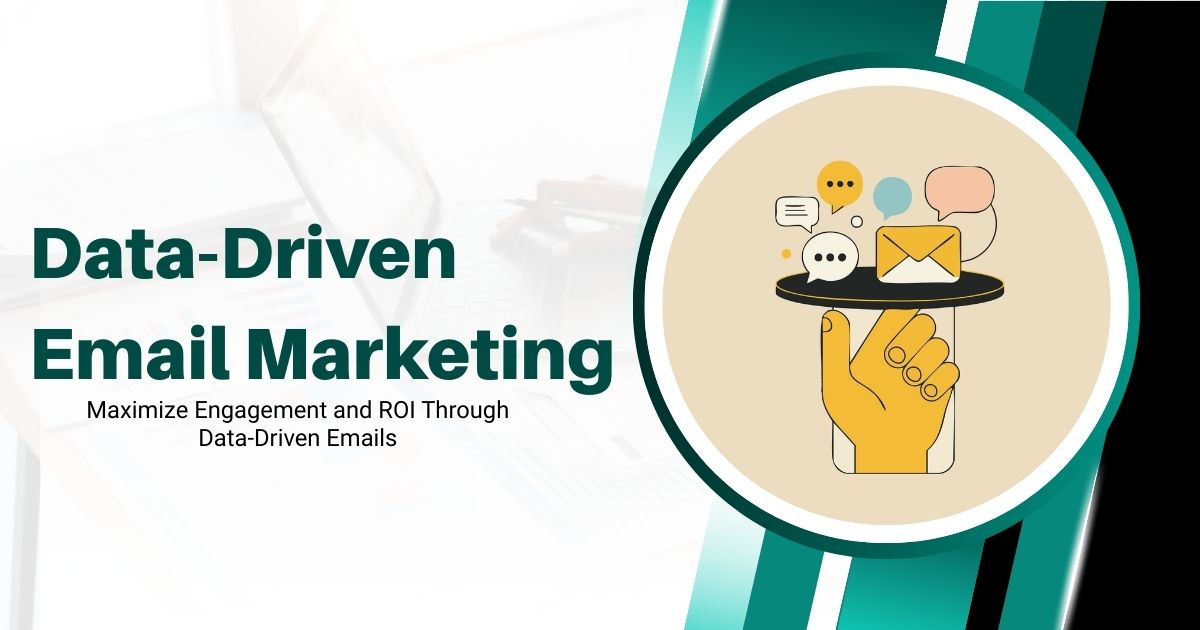
Data-driven email marketing uses subscriber data and AI to deliver personalized, timely campaigns that boost engagement, conversions, and ROI.
Email marketing remains one of the highest-performing digital marketing channels, with an average return on investment of $42 for every dollar spent. But sending generic blast emails to your entire subscriber list won’t cut it anymore. Smart marketers are leveraging data to create targeted, personalized campaigns that drive real results.
Data-driven email marketing uses subscriber behavior, preferences, and engagement patterns to inform every aspect of your campaigns. From subject lines to send times, content to call-to-action buttons, data guides your decisions and helps you create emails that resonate with your audience.
This approach transforms email marketing from guesswork into a precision instrument. Instead of wondering whether your campaigns will succeed, you can predict performance, optimize for better results, and continuously improve your strategy based on concrete insights.
Understanding Your Email Data Landscape
Before diving into specific strategies, you need to understand what data is available and how it can inform your campaigns. Email marketing platforms collect vast amounts of information about subscriber behavior, engagement patterns, and campaign performance.
Subscriber Data Types
Your subscriber data falls into several key categories. Demographic information includes age, location, gender, and job title. Behavioral data tracks website visits, purchase history, and email interactions. Engagement metrics show open rates, click-through rates, and time spent reading emails. Preference data reveals content interests, product categories, and communication frequency preferences. This information creates a comprehensive profile of each subscriber, enabling highly targeted messaging. You can also explore what is personalized data-driven marketing to understand advanced targeting techniques.
Preference data reveals content interests, product categories, and communication frequency preferences. This information creates a comprehensive profile of each subscriber, enabling highly targeted messaging.
Campaign Performance Metrics
Beyond individual subscriber data, campaign-level metrics provide insights into overall performance. Open rates indicate subject line effectiveness and sender reputation. Click-through rates measure content relevance and call-to-action strength. Conversion rates show how well emails drive desired actions.
Unsubscribe rates and spam complaints reveal potential issues with frequency, content, or targeting. Forward rates and social shares indicate content quality and subscriber satisfaction.

Segmentation Strategies That Drive Results
Effective segmentation is the foundation of data-driven email marketing. Behavioral segmentation, lifecycle stage segmentation, and engagement-based segmentation allow marketers to deliver highly relevant content. For a complete understanding, check out using data-driven marketing for better results.
Behavioral Segmentation
Behavioral segmentation groups subscribers based on their actions and engagement patterns. Recent purchasers might receive product recommendations or loyalty program invitations. Frequent browsers who haven’t purchased could get special offers or incentives.
Inactive subscribers need re-engagement campaigns with compelling content or win-back offers. Active subscribers who regularly engage can receive more frequent communications and exclusive content.
Lifecycle Stage Segmentation
Different subscribers require different approaches based on where they are in the customer journey. New subscribers need welcome sequences and brand education. Prospects might benefit from case studies and product demonstrations.
Existing customers appreciate updates, tips, and complementary product suggestions. Past customers could receive special offers to encourage repeat purchases.
Engagement-Based Segmentation
Subscriber engagement levels reveal preferences and inform frequency decisions. Highly engaged subscribers often welcome daily or multiple weekly emails. Moderately engaged subscribers prefer weekly communications.
Low-engagement subscribers need less frequent, highly targeted messages to avoid fatigue and unsubscribes.
Personalization Beyond First Names
True personalization goes far beyond inserting a subscriber’s name. Content personalization, local context, and dynamic content blocks improve engagement and conversions. You can explore how AI and data-driven marketing is reshaping customer engagement for advanced strategies.
Content Personalization
Product recommendations based on browsing history and purchase patterns increase relevance and conversions. Content suggestions aligned with stated interests and past engagement keep subscribers engaged.
Local weather, events, or news can add contextual relevance to your messages. Industry-specific content for B2B subscribers demonstrates understanding of their challenges and needs.
Dynamic Content Blocks
Dynamic content allows single emails to display different information for different segments. Product recommendations, promotional offers, and content sections can automatically adjust based on subscriber data.
This approach reduces campaign creation time while increasing relevance for each recipient.

Timing and Frequency Optimization
Data analysis reveals optimal sending patterns that vary by subscriber segment and industry. Testing different send times and frequencies helps identify what works best for your audience.
Send Time Analysis
Email platform analytics show when your subscribers are most likely to open and engage with emails. This data often reveals surprising patterns that differ from industry benchmarks.
B2B audiences might engage more during weekday mornings, while consumer audiences could prefer evenings or weekends. International subscribers require consideration of time zones and local customs.
Frequency Testing
Data helps determine optimal email frequency for different segments. Some subscribers want daily updates, while others prefer weekly or monthly communications. Testing and monitoring engagement metrics reveal preferences for each segment.
Frequency optimization often increases overall engagement by reducing unsubscribes and improving deliverability.
A/B Testing for Continuous Improvement
Systematic testing transforms assumptions into insights. A/B testing allows you to compare different approaches and identify what resonates with your audience.
Subject Line Testing
Subject lines significantly impact open rates. Testing different approaches—questions versus statements, urgency versus curiosity, short versus long—reveals subscriber preferences.
Personalization elements, emojis, and capitalization patterns can also be tested to optimize performance.
Content Testing
Email length, image usage, and content structure affect engagement. Testing different approaches helps identify optimal formats for your audience.
Call-to-action buttons, placement, and wording can dramatically impact conversion rates. Systematic testing reveals the most effective combinations.

Predictive Analytics and Automation
Advanced data analysis enables predictive capabilities that anticipate subscriber behavior and automate responses.
Churn Prediction
Analytics can identify subscribers likely to become inactive or unsubscribe. Predictive models consider engagement patterns, frequency preferences, and behavioral changes.
Early intervention campaigns can re-engage at-risk subscribers before they disengage completely.
Purchase Prediction
Behavioral data and purchase history can predict when subscribers are likely to make purchases. Automated campaigns can deliver targeted offers at optimal times.
This approach improves conversion rates while reducing marketing costs by focusing efforts on high-probability prospects.
Using Predictive Segmentation for Future Growth
Beyond reactive segmentation based on past behavior, predictive segmentation uses analytics to forecast future actions. By analyzing engagement patterns, purchasing trends, and lifecycle stages, predictive models can identify high-value subscribers likely to convert or churn.
This approach enables marketers to proactively tailor campaigns to retain at-risk subscribers or nurture prospects toward conversion. For example, a predictive model might identify a subscriber who hasn’t engaged in a month but has a history of high-value purchases. A personalized “we miss you” email with a special offer could prevent churn while strengthening brand loyalty.
Email Deliverability and Reputation Management
Even the best campaigns fail if emails don’t reach inboxes. Clean lists, double opt-ins, and monitoring engagement metrics help maintain deliverability. Avoid spam issues with how to avoid spam filters in email marketing.
Regularly cleaning your email list, using double opt-in mechanisms, and monitoring engagement metrics are essential practices. Data can identify patterns—such as certain subject lines or sending times—that trigger spam filters, allowing you to adjust strategies proactively. Maintaining a clean, engaged subscriber base ensures your messages reach the right people and your campaigns continue to deliver ROI.
Boosting Team Collaboration and Accountability
Automated receipt processing fosters better team collaboration. Approval workflows ensure that receipts are routed to the correct approvers, deadlines are monitored, and notifications are sent automatically.
This eliminates bottlenecks, reduces back-and-forth emails, and keeps employees accountable for timely submissions. Teams can focus on meaningful financial analysis and strategy instead of chasing paperwork.
Reducing Manual Bottlenecks in Expense Reconciliation
One of the biggest pain points for finance teams is reconciling expenses at the end of each month. Manual data entry slows down this process, often causing delays in reporting and cash flow management. Automated receipt processing can match receipts with invoices, purchase orders, and payments in real-time, drastically reducing reconciliation time.
This ensures that discrepancies are caught early, accounts are accurate, and finance teams can focus on strategic decision-making rather than chasing missing receipts. Businesses can close their books faster and maintain up-to-date financial visibility.
The Future of Receipt Automation: AI and Beyond

The future of receipt processing is increasingly AI-driven and predictive. Beyond extracting data, AI can forecast spending trends, detect anomalies in real-time, and even suggest cost-saving measures. Integration with machine learning algorithms means the system becomes smarter over time, requiring less human oversight.
Businesses that adopt advanced automation early gain a competitive edge—not only saving time and money but also leveraging data to make smarter operational decisions, similar to how companies use AI in digital PR campaigns to optimize brand reach and engagement.
Harnessing AI and Automation for Advanced Personalization
Artificial intelligence (AI) and automation are revolutionizing data-driven email marketing. AI can analyze complex data sets to identify patterns that humans may overlook, such as micro-segmentation opportunities or optimal send times for individual subscribers. Automation allows marketers to implement these insights at scale, sending personalized content at the right moment without manual intervention.
For example, AI-powered engines can recommend products based on a subscriber’s browsing behavior or predict when a user is most likely to make a purchase. Automated workflows can then deliver personalized emails automatically, ensuring subscribers receive relevant messages when they are most receptive. This combination of AI and automation maximizes efficiency and effectiveness, providing a competitive edge in today’s crowded inboxes.
Measuring the Lifetime Impact of Email Campaigns
Data-driven email marketing is not just about immediate clicks and conversions; it’s about long-term subscriber value. Measuring the lifetime impact involves tracking metrics like subscriber retention, repeat purchases, average order value, and overall contribution to revenue growth.
Using lifetime value (LTV) analysis, marketers can segment their audience based on profitability and tailor campaigns to maximize returns. High-LTV subscribers might receive exclusive offers and early access to products, while lower-LTV subscribers can be nurtured with educational content and value-driven campaigns to increase engagement. This strategic approach ensures email marketing investments are aligned with long-term business goals.
Performance Measurement and ROI Analysis
Data-driven campaigns require comprehensive measurement to demonstrate value and guide optimization efforts.
Attribution Modeling
Understanding how emails contribute to conversions helps optimize campaigns and prove ROI. Multi-touch attribution shows email’s role in longer sales cycles.
Revenue attribution directly connects email campaigns to business outcomes, justifying marketing investments.
Lifetime Value Analysis
Subscriber lifetime value calculations inform acquisition costs and campaign investments. High-value subscribers justify more expensive acquisition and retention efforts.
Segmenting by lifetime value enables targeted strategies for different subscriber groups.
Transform Your Email Marketing Today
Data-driven email marketing transforms guesswork into strategic advantage. By leveraging subscriber data, behavioral insights, and performance analytics, you can create campaigns that consistently deliver results.
Start by auditing your current data collection and segmentation capabilities. Identify gaps and opportunities for improvement. Implement systematic testing to optimize key campaign elements.
Most importantly, make data analysis a regular part of your email marketing routine. Regular review and optimization ensure your campaigns continue improving and delivering value for both subscribers and your business.
The marketers who embrace data-driven approaches will create stronger relationships with subscribers while achieving better business outcomes. Your data is already there—now it’s time to put it to work.
Frequently Asked Questions (FAQ)
How do I start collecting the right data for email personalization?
Begin by auditing your current email platform and CRM system to identify available demographic, behavioral, and preference data. Then, implement strategies like website tracking, preference centers, and engagement scoring to collect additional insights ethically.
How often should I update my segmentation strategy?
Segmentation should be revisited regularly, ideally quarterly. Continuous monitoring of engagement metrics and purchase behavior helps refine segments and ensures relevance as subscriber preferences evolve.
Can small businesses benefit from predictive email marketing?
Absolutely. Predictive analytics tools are accessible to businesses of all sizes. Even small datasets can provide valuable insights for anticipating subscriber behavior and improving personalization.
How do interactive emails impact conversions?
Interactive elements boost engagement by encouraging subscribers to interact with content, which increases click-through rates and time spent in emails. This interactivity often translates to higher conversions and stronger brand loyalty.
What is the best way to test email campaign effectiveness?
Use A/B testing to evaluate subject lines, content layouts, CTAs, and sending times. Combine results with predictive analytics and engagement metrics to optimize campaigns over time.
How do I ensure high deliverability rates?
Maintain a clean, engaged email list, monitor spam complaints, use proper authentication (SPF, DKIM, DMARC), and segment by engagement to avoid over-mailing inactive subscribers.
How can AI enhance email marketing for my business?
AI can predict subscriber behavior, recommend personalized content, optimize send times, and automate workflows. This improves efficiency and increases the likelihood of conversions while saving marketing resources.
Leave a Reply